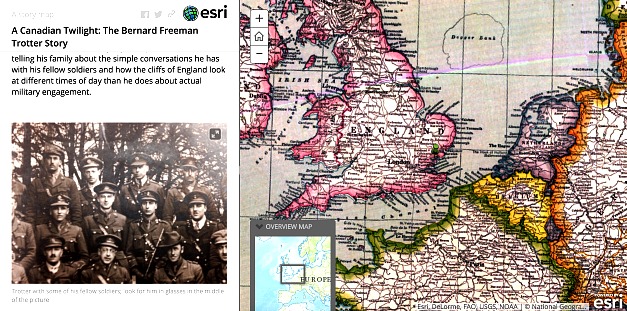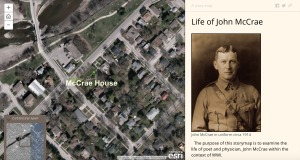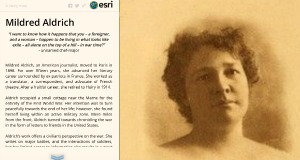21st century tools provide students with a window into life during the Great War

In HUMAN 2DH3: Introduction to Digital Humanities, students fused text, images and multimedia content with maps from the Library’s extensive WW1 maps collection to explore the lives of four prominent figures who experienced World War One.
What was it like to be in the midst of an artillery barrage? Or to be a single woman living alone on the edge of a war zone?
An innovative new course is helping students combine digital technology and archival materials to better understand and share the experiences of those who fought and lived through the First World War.
Developed by a team of interdisciplinary instructors from McMaster University Library and the Lewis and Ruth Sherman Centre for Digital Scholarship, HUMAN 2DH3: Introduction to Digital Humanities teaches students to use modern research technologies like mapping and text analysis software, to study and present historical scholarship in a new way.
“Digital humanities encourages people to think very actively about how to make research accessible in a visual sense, and make it available to a broad audience.” says Paige Morgan, a postdoctoral fellow at the Sherman Centre and one of the course instructors. “I want students to walk away with a rich and complicated vision of the ways in which they might create something that will connect not just with scholars, but with any number of people.”
Throughout the course, students worked in groups to create a digital story map that examined different aspects of World War One told through the archival materials of four individuals who experienced the war: John McCrae, Mary Augusta Ward, Bernard Freeman Trotter and Mildred Aldrich.
To create their projects, students fused text, images and multimedia content with maps from the Library’s extensive WW1 maps collection.
Students were introduced to a range of digital techniques including map and aerial photo interpretation, geo-referencing, video and image editing, text analysis tools, and web design.
“The idea was to introduce students to the software and get them asking each other questions and figuring out how they could use those tools to tell a story.” says Jay Brodeur, manager of Maps, Data, GIS department in the University Library and a course instructor. “That process of not being afraid to experiment with technology, of trying things out knowing that they might not work, breaking things and then figuring out how to fix them- I think that process is critical to being a scholar in the 21st century.”
Lauren Karrys is s third year gerontology student whose group was asked to create a story map featuring McMaster alumnus, poet and soldier, Bernard Freeman Trotter.
Karrys says the experience taught her the impact that digital technologies can have on scholarship and provided an opportunity to interact with archival material in a meaningful way.
“We were taught a wide range of digital technologies to explore large information and text corpuses and we were able to see recurring trends that may have taken months to uncover had we done it manually,” says Karrys. “It was also powerful to research Bernard and go down to the archives and hold the last letter he’d written home before dying in France during the war. It was a fascinating discovery process.”
The course was offered for the first time this winter and will be offered again in 2016. In the meantime, the Sherman Centre will continue develop Digital humanities courses focused on different themes.
Morgan says since Digital humanities is a growing trend worldwide, it’s important to continue to find ways to expose students to this form of scholarship.
“Once upon a time, no one knew what Twitter was and now it’s ubiquitous. Digital humanities is likely to become just as commonplace – just another part of Humanities research.”
Explore the digital story maps created by the students in HUMAN 2DH3 Introduction to Digital Humanities:
Bernard Freeman Trotter, McMaster alumnus, poet and soldier
Mary Augusta Ward, British novelist
John McCrae, Canadian poet, physician, author, artist and soldier
Mildred Aldrich, American journalist and writer




